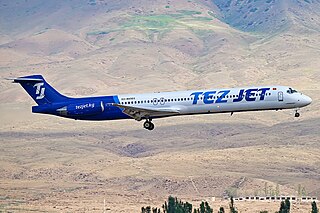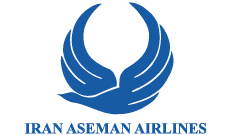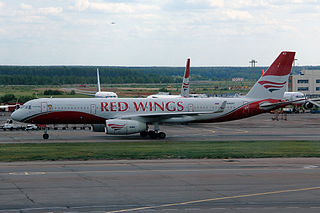
The McDonnell Douglas MD-80 is a series of five-abreast single-aisle airliners developed by McDonnell Douglas. It was produced by the developer company until August 1997 and then by Boeing Commercial Airplanes. The MD-80 was the second generation of the DC-9 family, originally designated as the DC-9-80 and later stylized as the DC-9 Super 80 . Stretched, enlarged wing and powered by higher bypass Pratt & Whitney JT8D-200 engines, the aircraft program was launched in October 1977. The MD-80 made its first flight on October 18, 1979, and was certified on August 25, 1980. The first airliner was delivered to launch customer Swissair on September 13, 1980, which introduced it into service on October 10, 1980.

Iran Aseman Airlines is the third-largest Iranian airline headquartered in Tehran. It operates scheduled domestic passenger services and regional international services.
Caspian Airlines is an airline headquartered in the Iranian capital of Tehran. Established in 1993, it operates services between Tehran and other major cities in Iran as well as international flights to Turkey and Iraq. Its main base is Mehrabad International Airport, Tehran.

Southwest Airlines Flight 1248 was a scheduled passenger flight from Baltimore, Maryland, to Chicago, Illinois, continuing on to Salt Lake City, Utah, and then to Las Vegas, Nevada. On December 8, 2005, the airplane slid off a runway at Midway Airport in Chicago while landing in a snowstorm and crashed into automobile traffic, killing a six-year-old boy.

Mashhad International Airport is an international airport located in Mashhad, Razavi Khorasan, Iran.

A runway excursion is a runway safety incident in which an aircraft makes an inappropriate exit from the runway.

Southwest Airlines Flight 1455 was a scheduled passenger flight from McCarran International Airport, Las Vegas, Nevada, to Burbank-Glendale-Pasadena Airport, Burbank, California, that overran the runway during landing on March 5, 2000. The aircraft, a Boeing 737-3T5, registration N668SW, came to rest on a city street adjacent to a gas station. The National Transportation Safety Board found that the incident was due to the pilots attempting to land with excessive speed. They also found that the air traffic controller placed them in a position from which their only option was a go around. Two of the passengers were seriously injured, and there were many minor injuries. As a result of the incident, the airport installed an Engineered Materials Arrestor System at the east end of the incident runway. The aircraft was written off, making the incident the 10th hull loss of a Boeing 737-300. This was the first major accident in the airline's 29-year history.
Mahshahr Airport is an airport in Mahshahr, in Iran's Khuzestan province.
Ameristar Air Cargo, Inc. is an American passenger and cargo airline based in Dallas, Texas, United States. It operates passenger and cargo services in the Americas and acts as a broker to other cargo carriers. Its main base is Addison Airport in north Dallas, with hubs at Willow Run Airport and El Paso International Airport.

FedEx Express Flight 14 was a scheduled cargo flight from Singapore to Newark, New Jersey, via Malaysia, Taiwan, and Alaska. On July 31, 1997, the aircraft flying this route crashed during landing on its final segment at Newark International Airport (EWR), inverting and catching fire, injuring all five people on board.

On 22 December 2009, an American Airlines Boeing 737-800, operating American Airlines Flight 331 and carrying 148 passengers and six crew, overran runway 12 on landing at Kingston in poor weather. The plane continued on the ground outside the airport perimeter and broke apart on the beach, causing injuries.

Southwest Air Lines Flight 611 was a scheduled flight from Naha to Ishigaki. On 26 August 1982, the Boeing 737-200 overran the runway while attempting to land. The aircraft caught fire and was destroyed, but none of the 133 passengers and 5 crew died in the accident although two crew and one passenger were seriously injured.

Red Wings Airlines Flight 9268 was a Tupolev Tu-204-100 passenger jet that on 29 December 2012 crashed on landing at Moscow Vnukovo Airport, Russia, following a repositioning flight from Pardubice Airport, Czech Republic. There were no passengers on board, but 5 of the 8 crew members were killed when the aircraft hit a ditch and highway structures after overrunning the runway.

Zagros Airlines is an Iranian airline headquartered in Tehran and based at Mehrabad International Airport.

Pegasus Airlines Flight 8622 was a domestic flight from Ankara to Trabzon, Turkey. On 13 January 2018, while landing on runway 11 at Trabzon Airport, the aircraft operating the flight ran off the left side of the runway and partially slid down a cliff. While there were no fatalities nor injuries of the 168 passengers and crew, the aircraft was damaged beyond repair and subsequently written off.

On 14 January 2019, a Boeing 707 operated by Saha Airlines on a cargo flight crashed at Fath Air Base, near Karaj, Alborz Province in Iran. Fifteen of the sixteen people on board were killed. This aircraft was the last civil Boeing 707 in operation.

PenAir Flight 3296 was a domestic scheduled flight from Ted Stevens Anchorage International Airport in Anchorage, Alaska, to Unalaska Airport on Amaknak Island in the Aleutian Chain of Alaska. On October 17, 2019, the Saab 2000 operating the flight overran the runway after landing at its destination airport. Of the 42 passengers and crew on board, one passenger was fatally injured when a propeller blade penetrated the fuselage, one was seriously injured and ten suffered minor injuries. The aircraft was substantially damaged during the accident and written off.














